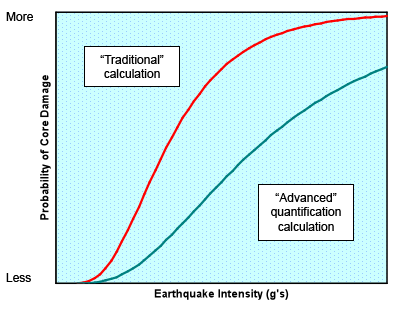| The advanced quantification process solves a 30-year mathematical limitation related to model precision and will result in more accurate results for
increasingly complex probabilistic risk assessments.
Probabilistic risk assessments (PRAs) are used for all U.S. nuclear plants and most non-U.S. nuclear plants to enhance understanding of the potential
challenges to safe operation. PRA analysts have long struggled to develop models in sufficient detail to analyze the risks of these complex systems
while maintaining the practical ability to solve the models. Moreover, the models have expanded in scope to cover not only operational upsets but
external hazards such as fire and seismic events that can present risk to the public.
An advanced quantification process developed by EPRI resolves two issues created by the simplifications typically made to solve the PRA models. The
value of this advanced quantification process has been demonstrated in the seismic PRA for a European plant, and the process is now being incorporated
into the software tools used every day by many nuclear utilities.
The two simplifications are the use of truncation limits and the rare event approximation. Both simplifications can impact the accuracy of the model
results, but both can be difficult to measure. Truncation limits allow the computations to cease searching for contributions to risk when these
contributions are very small. The rare event approximation is used when the events modeled are rare to avoid very complex (and resource-intensive)
calculations that would otherwise be needed in computing risk estimates.
As PRAs encompass a broader range of events - such as fire and seismic - the models become larger, making it increasingly difficult to ensure that
truncation limits have been set appropriately. Further, the probabilities of failure, conditioned on the occurrence of a severe challenge like a large
earthquake, may be large enough that the rare event approximation is not a valid simplification. The new computational algorithms and application
approach provide an efficient and effective solution to both the truncation and rare event approximations. The accompanying figure conceptually
illustrates a possible change in risk due to the application of the advanced quantification method.
Use of the advanced quantification approach has benefits beyond enabling improved risk estimations for the spectrum of hazards at a nuclear plant. By
providing a more accurate assessment of risks and the relative contributions to these risks, the refined analysis helps to ensure that the appropriate
resources are assigned to the most risk-significant issues. The advanced quantification process has been applied at several nuclear power plants for
risk analyses. Applying the advanced quantification method results in up to a 45% reduction in the calculated risk for internal events. The results can
be far more dramatic for seismic risk analyses.
For more information, contact Stuart Lewis at 865-218-8054 or slewis@epri.com.

|